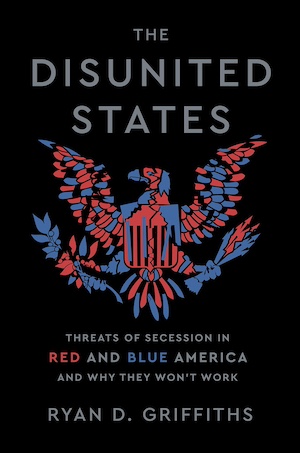Ryan D. Griffiths The Disunited States: Threats of Secession in Red and Blue America and Why They Won't Work Oxford University Press 200 pages 6 x 9 inches ISBN: 9780197816257
In a nutshell
The book is about secession in America. There is a growing interest in secession, or what some refer to as a national divorce between Red and Blue America. There is a developing literature on this topic, and one Axios poll found that 20% of Americans support a national divorce.
The key factor driving this interest in secession is polarization. Whether it is the Red-State secessionists, the BlueExiters, the California Independence Party, or the Texas Nationalists, they all point to unstoppable polarization and political dysfunction as the reason secession is necessary. They have lost faith in the American political system.
The book outlines three common arguments that secessionists make: (1) That the two sides have irreconcilable differences (the polarization argument); (2) That secession is a legal right; and (3) That smaller political units are better. The book draws on interviews with secessionist organizations, and considerable time is spent developing their positions.
Secession occurs when part of a sovereign state breaks away to form its own recognized sovereign state. The American Civil War was an attempt at secession, just as the American Revolution was a successful case of secession. There are roughly 70 active secessionist movements in the world, and the last state to be born via secession was South Sudan in 2011.
The thesis of the book is that while polarization is a serious problem in America, secession is not the solution. Roughly half of secessionist movements turn violent, and most of them fail to gain independence. When they do secede peacefully, it is when specific conditions hold. There is a distinct and regionally concentrated nation, with clear internal borders, and a special administrative status that justifies why that nation can secede when others cannot. The Czechoslovak Velvet Divorce was an example. But these conditions do not hold in America.
The attempt to divide America into two or more countries would almost certainly produce great violence. The so-called red and blue populations are intermixed, and many Americans hold moderate positions. Trying to unmix that population and disassemble the country would create a cascade of hyper-polarization and ideological conflict.
The book is written for a general audience. It argues that rather than turning to secession as a solution to America’s problems – and this is a false solution – the better choice is to target the roots of polarization and seek common ground.
The wide angle
I have written several books and articles on the dynamics of secession historically and globally. In an earlier book, Secession and the Sovereignty Game: Strategy and Tactics for Aspiring Nations (2021), I conducted interviews with over a dozen secessionist movements in places like Catalonia, West Papua, and Northern Cyprus. Although my interest in this topic began as a graduate student, I was drawn to the subject as a global phenomenon and not as a particularly American one.
The reason I decided to write The Disunited States is that I began to witness a growing interest in American secession. I understand, of course, the polarization is feeding that interest. But those who advocate for secession in America are generally unaware of the difficult process through which secessionist regions can join the community of sovereign states. For instance, there are complex recognition practices and a general agreement that secessionists cannot just unilaterally choose to become a country. Their home state needs to agree.
Most secessionists, not just in America but globally, think that wishful thinking and a good argument can win them independence. But the realities of secession are far more complicated. Importantly, it is understandable that secessionists rarely know how the process works. State birth via secession is not a regular occurrence, and there is no set of laws and guidelines for how it should be conducted. It is a process that typically transcends law, one that becomes deeply political and prone to conflict.
I do not offer a solution to polarization in this book. Instead, I bring to the table an expertise on how secession works around the world. I think that knowledge is currently absent in the developing conversation about secession as a solution to polarization. I contend that it is not the solution that secessionists think it is.
The book is written for a general audience and deliberately eschews unnecessary academic jargon. But it does discuss the patterns in secessionist conflict, it brings the relevant work in political science to bear on the topic, and it even delves into the American constitutional debate on the legality of secession.
Along the way, I provide a few dystopian vignettes of how badly and violently I think secession in America would play out.
A close-up
There are two sections that I hope browsers would encounter. The first is from a section at the beginning called the Year of Two Presidents. It is a fictional vignette that imagines a 2032 Presidential election in the context of extreme polarization, one that collapses into a violent civil war.
The two candidates are Alexandria Ocasio-Cortez and Donald Trump Jr. By the time of the election, American politics has become hyper-polarized and both parties think that they need to win at any cost. Political violence has become common. The election results are so close, and the attempts at cheating are so rampant, that both candidates end up claiming the Presidency and denouncing the other.
What follows is the establishment of two Presidential administrations, one based on Washington D.C. and the other in Florida. Political violence begins to spiral out of control and martial law is declared. As the situation disintegrates and the fear and distrust metastasize, some leaders call for a national convention to divide the country. But they quickly run into obstacles such as how borders would be drawn, who decides, and how many countries should be created.
Eventually, the United States collapses into five new states that each possess additional secessionist movements. There is substantial inter-militia violence and internal refugee crises. The section ends when Russia and China recognize the new states and offer to send peacekeeping forces to alleviate the suffering and end the violence.
The second section that might interest browsers is a chapter called “Three Blueprints for American Divorce.” In the chapter, I attempt to map out different ways that America could be divided between a so-called Redland and Blueland. I discuss three blueprints based on: (1) a division by red and blue states; (2) a division by red and blue congressional districts; (3) a division by red and blue counties.
The blueprints illustrate the fundamental problem of trying to divide a population of 340 million Americans who are quite intermixed geographically and ideologically. Most of America is purple and political divisions run through neighborhoods and households.
The three blueprints demonstrate what I call the “scale problem.” That is, there is no way to draw new borders that both create a rational map and reduce the political minority problem. The scale at which you draw the map come with tradeoffs. If Redland and Blueland are divided by states, then the map is somewhat coherent, but millions of Americans will find themselves in the wrong country. If the map is divided by the 5,000 or so counties, then more Americans will be properly sorted into the country they want, but the resulting map will be a hopeless jigsaw of intermixed islands of red and blue.
The chapter includes maps and is a useful and interesting way to think through the fundamental challenges of disassembling America.
Lastly
This is a non-partisan book. It was not written for Red America or Blue America; it was written for all Americans. One of my hopes is that it will interest readers from across the political spectrum.
Another central aim in the book is to convince the reader that secession won’t work. This is not easy to do because once an individual believes in a secessionist cause, it is hard to change their view. Most secessionists will see the issue through an ideological lens. That is, they will argue that groups of like-minded individuals (or nations) ought to have a right to create their own state if the current one is broken. However, that is an ideological argument and not one based on pragmatism. In the book, I do not take a position on normative claims about deserving independence. I contend that when it comes to secession, it’s not simply about whether a group is righteous, there is also the reality of how secession works, and how it can rapidly descend into violence. This is one of the things I want the reader to understand.
My aim is to shift the reader’s attention to the extreme practical challenges of trying to disentangle a hopelessly entangled population. America is simply not set up in a way that will enable a smooth and peaceful national divorce.
I also want to explain that while the analogy between secession and marital divorce has some usage, it is nevertheless imperfect. A marriage consists of only two individuals and not 340 million. Marital divorce managed by domestic law and there are guardrails in place to prevent it from becoming overly conflictual. There are no such guardrails in place for secession between Redland and Blueland. It would truly be anarchy.
Finally, I end the book with a short plea for seeking common ground. Although it is far from perfect, America has made countless achievements. Its people are far less polarized than its current leadership, and they still have much to offer as a united nation.
.jpg)




